Chiloé Island has a lot for visitors to see including churches and scenic views. You’ll need a car and two or three days to get a good feel for the island, but not all visitors have that much time. So many visitors, myself included, visit Chiloé on a day trip from Puerto Varas. You won’t see everything, but this brief taste is enough to make visitors want to return for a longer visit.
I chose to visit Chiloé not just as a day trip, but with a guided tour. I didn’t have a rental car and without it, this day trip becomes nearly impossible. So, in this article, I’m going to cover exactly what you should expect on a Chiloé Island day trip.

Booking Your Tour
While there are options to book a tour online through popular sites like GetYourGuide and Viator, I chose to wait until I was in Chile to book my day trip and I think that was a great decision.
As I looked at a day trip to Petrohué Falls and the Osorno Volcano, I noticed that prices were double if I booked as a solo traveler. In Puerto Varas, my hostel was able to arrange everything and it worked out to be cheaper than if I had booked online in advance.
One of the biggest positives was that my hostel was able to guarantee that I would be on a tour that spoke at least some English. After my tour to El Cajon del Maipo ended up having no English at all (despite booking an English tour), this was a great relief.
At the time of booking (October 2023), this cost me 30,000 pesos, plus an additional 9,000 pesos for a boat trip (to be paid in cash) and an additional 14,000 pesos for lunch. The 9,000 pesos was mandatory but the 14,000 pesos for lunch could technically be considered optional.
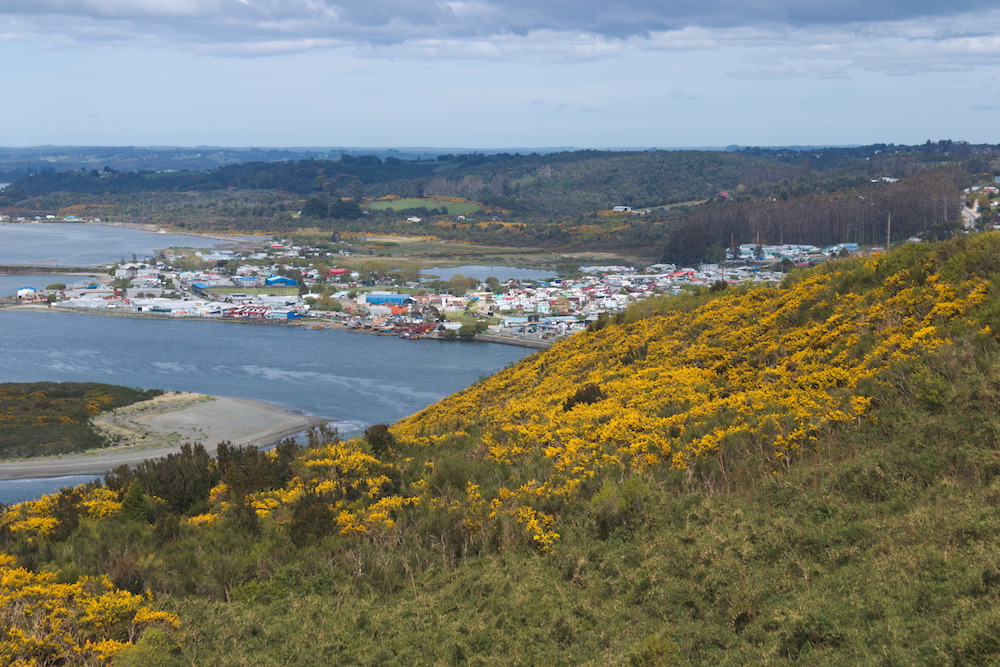
What Does Your Tour Look Like
Now that we’ve that we’ve talked about booking your trip, let’s talk about what you can expect on a day trip to Chiloé.
Ferry to Chiloé
After being picked up from your accommodation, the journey south to the island of Chiloé begins. It’s about a 30 minute drive to Puerto Montt where you’ll board a 30 minute ferry to start your journey. On the ferry, you can climb to the top deck for some nice views.
I recommend bundling up. When I took this ferry, it was pretty cold up top.
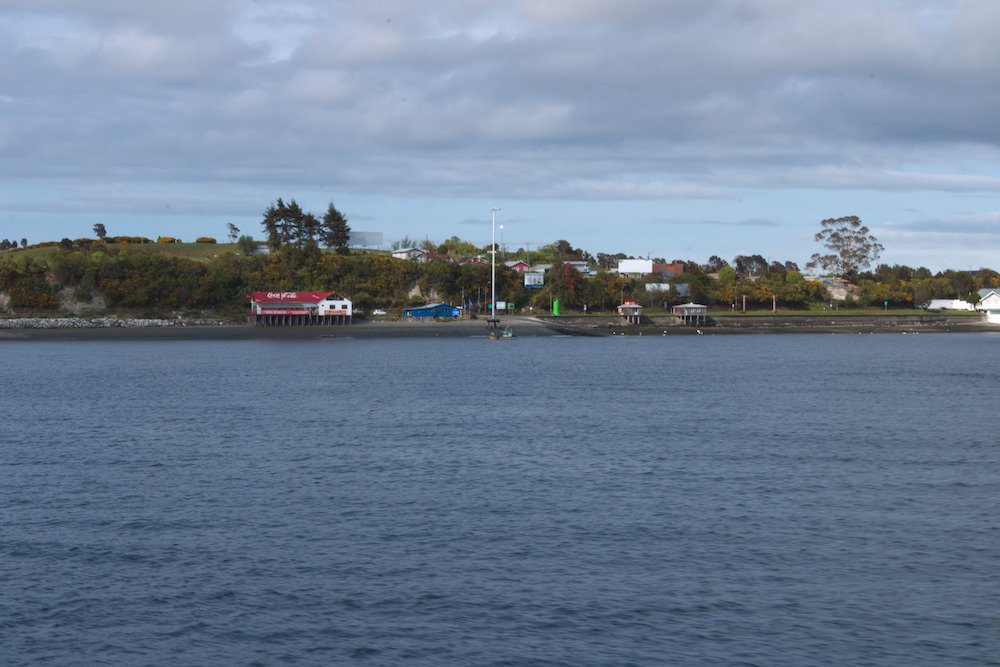
The Village of Chacao
When we arrived on the island of Chiloé, our first stop was the small village of Chacao. We only had about 20 minutes here, but that’s really all you need because there isn’t much to see. Stop in the church and notice how the main statue of Jesus is not on the cross.
Outside of the church, you can take a short stroll around the main square. You’ll find a few shops all selling local, handmade goods. Most shops sell the same things, but you’ll see the workers crocheting mittens and hats while they wait for buyers. And if you see someone selling some bread, get some to try. The bread is delicious and is made with little pieces of meat, making it more savory than your typical bread.
After your visit, you’ll hop back in the van. It’s about an hour drive to your next destination, but the drive was pretty so I didn’t mind.
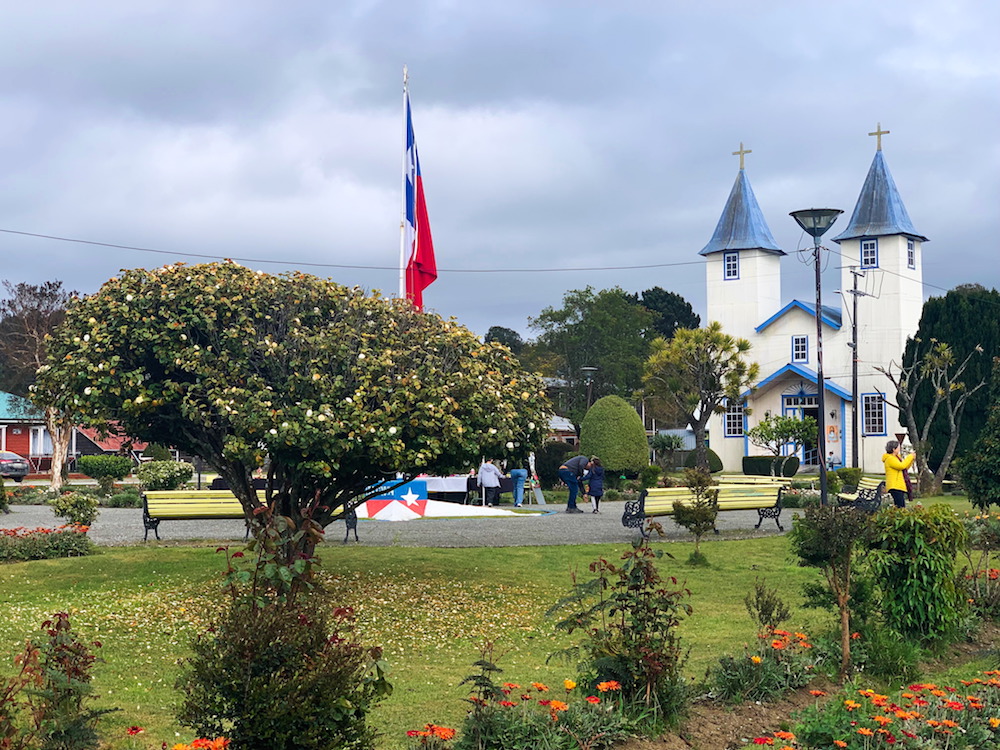
Piñuhuil
The next stop was the highlight of the tour of Chiloé Island, at least for me. At Piñuhuil, you’ll pay a 9,000 peso fee and board a boat. From there, you’re taken out to three tiny islands where penguins come to lay their eggs. The penguins live in the water for six months out of the year, but return to land to lay their eggs.
They lay their eggs at the top of the island so it’s difficult (read: impossible) to see them from the boat. But, the penguins make their way down the island to find food, so if you’re lucky, you’ll see some walking (and falling!) their way into the water.

If you want to try to get a photo, make sure you have a good zoom on your camera. We saw eight penguins but because of the distance, I can’t really say I got many good photos.
As a note, this part of the tour was only in Spanish as the boat guides (or at least the guide on my boat) only spoke Spanish. However, there was one tourist on our boat who was fluent in both Spanish and English who worked with the main guide and provided translation for those of us who spoke very poor (if any) Spanish. I realize here that I was very lucky, because there’s no guarantee that just because you’re on an English tour, you’ll get an English guide at Piñuhuil because your main tour guide does not join you on the boat.

Lunch
Our stop for lunch on Chiloé Island was at a restaurant within walking distance of the boat tour at Piñuhuil. There were plenty of options and the food was fine. It was good, but the meal I had on the tour the day before was definitely better. After lunch, it’s back in the van to start working our way back to the ferry port.
The Market at Ancud
We stopped in the small town of Ancud to visit the local market. I have to give a massive shout out to my guide here who took it upon herself to walk me through the produce section to show me some of the more unusual foods that I definitely don’t have back home in Wisconsin. It was greatly appreciated.
On the first level of the market is food, but climb the stairs and you’ll find more artisans. A lot of the things felt very similar to what we saw in Chacao, but I did buy myself a pair of mittens. Wisconsin winters are cold and the handmade mittens were cute.
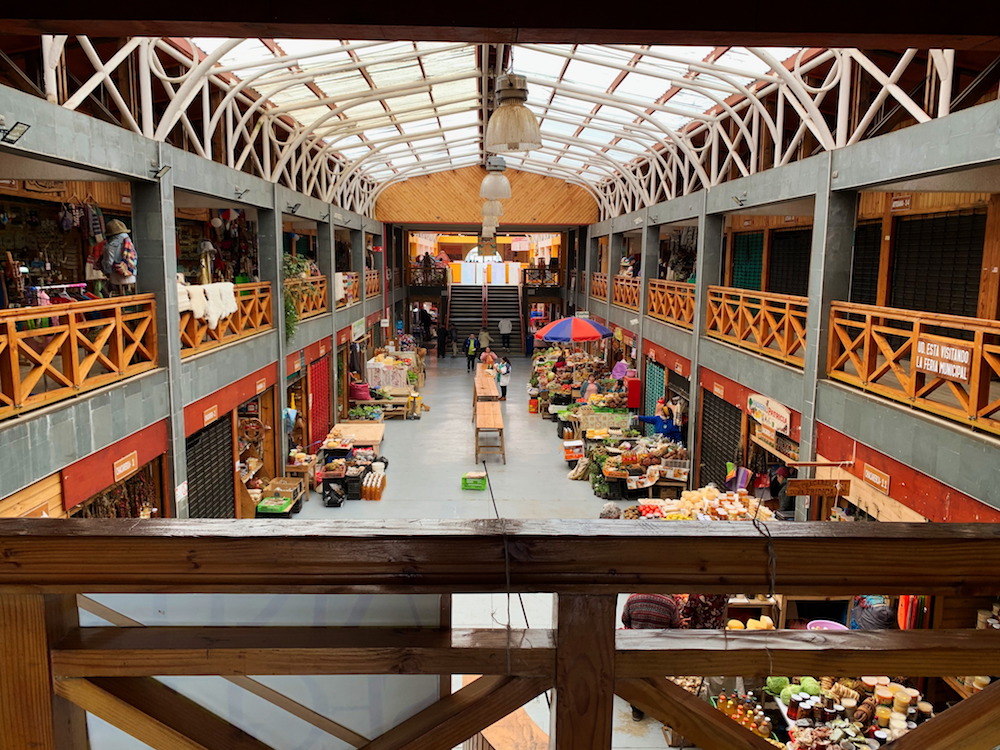
San Antonio Fort (Fuerte San Antonio)
Our last major stop of the day was at the last Spanish Fort in Chile. Again, my guide went above and beyond to give me the historical context. Long story short, this fort was the last Spanish outpost in Chile’s war for independence. So while it is historical, the views here are pretty great too.

Mirador Cerro Hueihuen
Our last true stop was a viewpoint that provided a lovely of the sea and the island of Chiloé. It was a quick stop, just long enough to get some last pictures, but the view was incredible and a great way to end our time on Chiloé.
Back to Puerto Varas
From the last viewpoint, we had a 30 minute drive back to the ferry port, then a 30 minute ferry ride, and a 30 minute drive back to Puerto Varas.
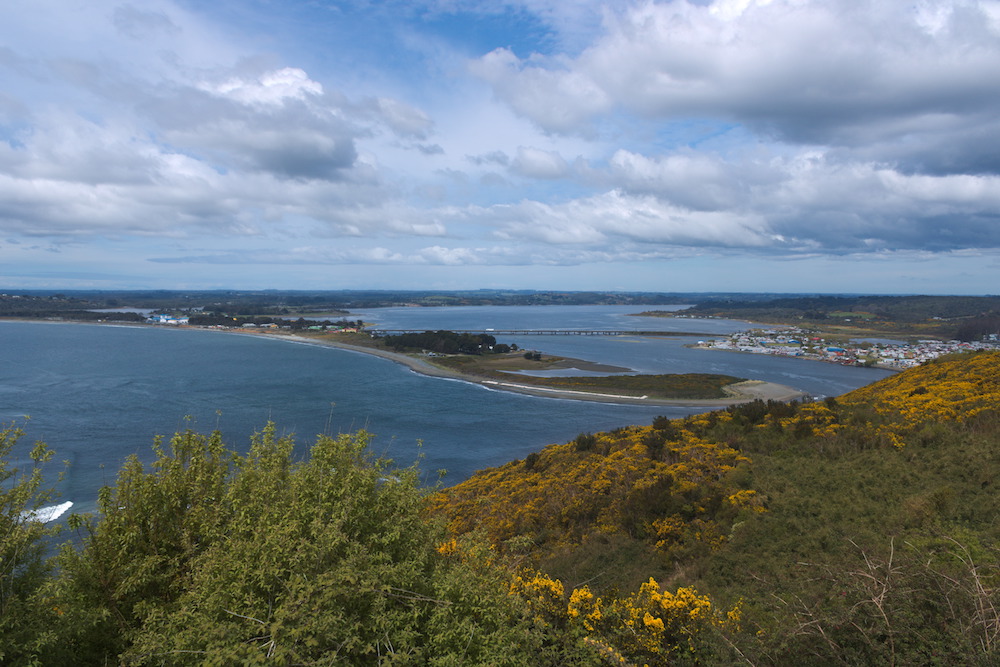
What to Know Before Your Tour
This day trip requires a lot of transportation. In some ways, it feels like all you do is drive from one place to the next. I don’t mind days like this as long as the route we’re driving is scenic. Luckily for me, with the exception of the drive between Puerto Varas and Puerto Montt, the route was very scenic. But, if you want something more active and with less transportation, you should consider other alternatives, such as the Osorno Volcano and Petrohué Falls.
Make sure to bring cash with you. You’ll need it to board the boat in Piñuhuil and you don’t want to miss the opportunity to see wild penguins. Lunch is also not included so make sure that you have budgeted accordingly.
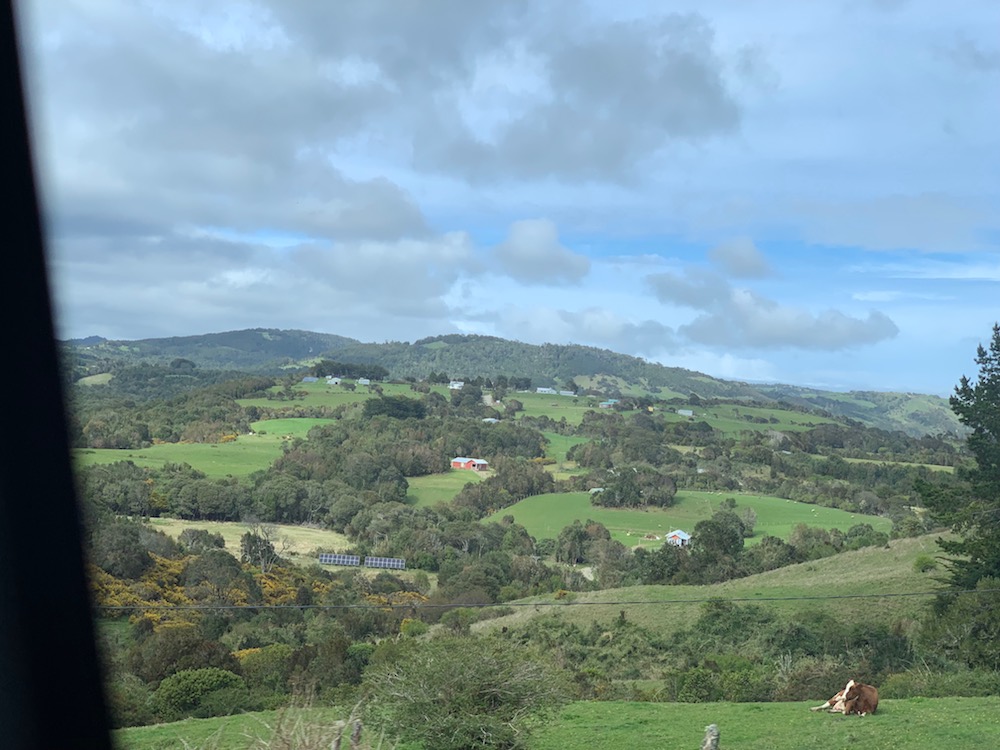
When to Visit
Peak tourist season is the summer months, but because you are in the southern hemisphere that means December through February. One of my tour guides mentioned that when the cruise ships come in, there are just so many people. At nearby Petrohué Falls many as 2,000 people can visit Petrohue Falls in one day. The parking lot near Puñihuil will be filled with cars and boats so you may not get the calm penguin spotting experience that I had.
On the other hand, many businesses will close for the winter months (June through August).
So, I recommend aiming for shoulder season. The weather may not be as great as peak season, but you’ll have significantly fewer crowds. I visited in October and had great weather, but I think I may have been an anomaly. I’d recommend looking at late October to November or March to April for your visit.

Is a Day Trip to Chiloé Island Worth It?
For me, the answer is yes. But I will give the caveat that the island of Chiloé deserves more than just a day trip from Puerto Varas. There’s a lot to see on this island and I barely even scratched the surface. Chiloé is definitely on my list to return to one day.
But that all said, you need to determine if all the time spent in the van is worth it to you. If you are expecting more sightseeing, this is not the tour for you.
More in Puerto Varas
Chilóe Island is just one day trip from Puerto Varas. The town itself is cute, but it’s small and there’s not a lot to do. That said, there are some nice parks and great views if you have a little down time.
That said, the best thing to do in Puerto Varas is to explore the nearby nature on one of its many day trips. The Osorno Volcano and Petrohué Falls is arguably the most popular but it’s by no means the only day trip. And it’s not just guided tours. There are DIY day trip options like visiting the town of Frutillar.
Final Thoughts
One day is not enough time to explore all of Chiloé Island, but it’s a great taster. For those with limited time, I do recommend this, but just note it is a lot of driving. Without a doubt, after your day trip, you’ll want to return to see even more of this beautiful area of Chile.
Continue Your Adventure
Puerto Varas: Considered by some to be the gateway to Patagonia, the town of Puerto Varas is a delight to explore. There are several amazing day trips from Puerto Varas. Chiloé Island is great for some travelers, but not others. A trip to Petrohué Falls and Osorno Volcano is great for all travelers.
Chile Itinerary: For first time visitors, I recommend my 9 Day Chile Itinerary or my 7 Day Itinerary. Visit the capital city of Santiago, the beaches in Viña del Mar, and head south to Puerto Varas.
Chile Travel Guide: Check out my Chile Travel Guide for everything you need to start planning your trip, including itineraries, city guides, travel tips, and a detailed budget.

this article is very useful, thank you for making a good article